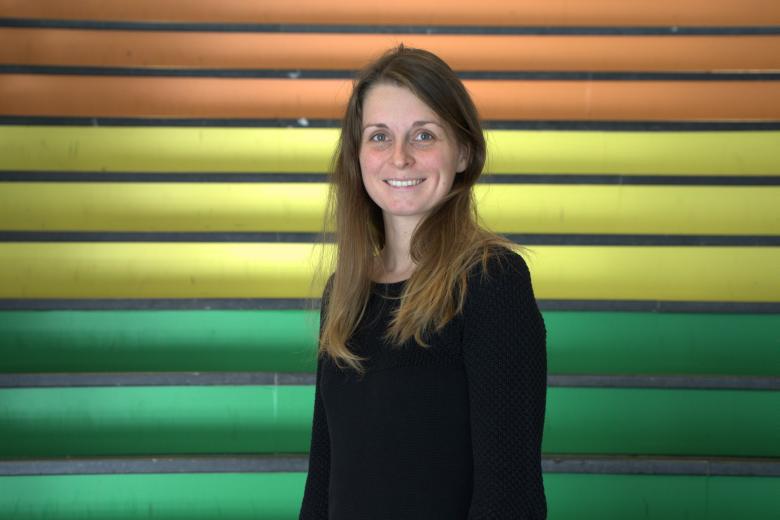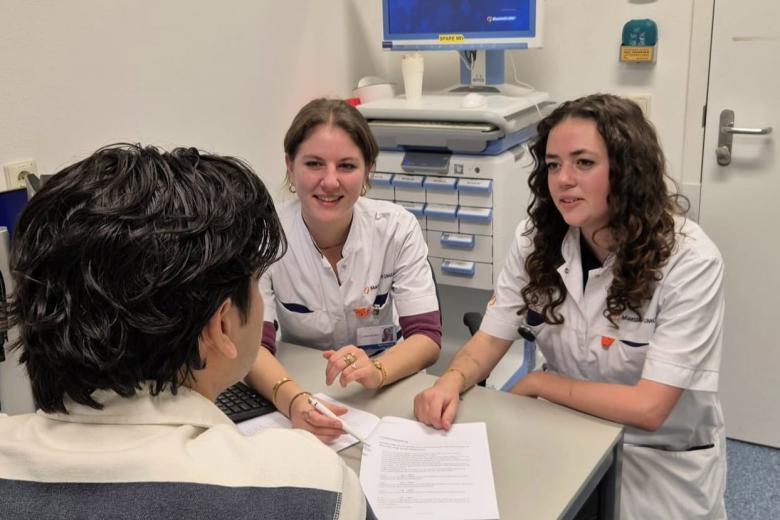Digital health: measuring your pulse on your phone
At the Faculty of Health, Medicine and Life Sciences, staff and students strive to make a difference. For instance, Bram and Jan focus on programming, and Kim is working at the Faculty Council. In 'Nice to meet you' these individuals introduce themselves and share their work within FHML.
Dominik Linz is a cardiologist, professor of Comprehensive Atrial Fibrillation Management and head of Electrophysiology at the Cardiovascular Research Institute Maastricht (CARIM) and the Heart+Vascular Center within Maastricht UMC+. Additionally, he is professor of Lifestyle Factors in Cardiac Arrhythmia in Copenhagen. He focuses on the treatment of arrhythmias and digital health: using technology within healthcare. During the upcoming Pulse Day, he aims to demonstrate how simple it is to measure your own pulse using an app on your phone. “The goal is to collect more than a thousand digital pulses in Maastricht.”
Dominik grew up in Mainz, Germany. “I studied there as well,” he says. “After my studies, I did a PhD in Maastricht and completed my training as a cardiologist in Homburg, Germany. Then, I spent three years in Australia, where I did a fellowship focusing on arrhythmia treatment. I returned to Maastricht in 2019. Shortly after, the COVID-19 pandemic began. Due to the pandemic, we set up a research line around digital health and remote care. For example, we are working on various apps that we use together with patients, collecting a lot of data and conducting research. My other research line is focused on the treatment of atrial fibrillation, a specific arrhythmia where the heart rate is irregular. I have been very interested in arrhythmias and their treatment since my student days, and I still am.”
Collaboration
Additionally, Dominik works as a professor in Copenhagen. “On average, I spend three weeks per month in Maastricht and one week in Copenhagen. We have an animal laboratory there,” he explains. “Through the collaboration between Maastricht and Copenhagen, we can quickly bring clinical questions to this lab. We can also apply the findings from the animal laboratory directly to the treatment of arrhythmias. I think this is a very unique and effective way of conducting interesting research together.”
One in three
Dominik is also involved in Pulse Day, an international awareness campaign about arrhythmias. “Pulse Day was initiated by the European Heart Rhythm Association (EHRA) to explain that arrhythmias are very common,” he explains. “This campaign takes place on 1 March, the first day of the third month, because one in three people worldwide will develop an arrhythmia in their lifetime. We want to show everyone that measuring your pulse is very simple. You can do this by placing your finger on your wrist, but you need to know how to interpret the result. We have another way: an app on your phone, where you can measure your pulse by placing your finger in front of the camera. The result then appears directly on your screen, so you can easily see if the pulse is fast or slow, regular or irregular, and what that means.”
More than a thousand digital pulses
The goal is to collect more than a thousand digital pulses in Maastricht with this app by mid-March. “Everything is anonymous: we can only see how often the app is used, but the information cannot be traced back to specific individuals,” says Dominik. “That is not the purpose of this campaign. The goal is to see if apps like this, which are normally used for patients, can be used more broadly to create awareness among the general public.”
Blood pressure or diabetes
Dominik also wants to explore whether similar apps could be used for other health goals. “If you want to measure your pulse at the general practitioner, it creates a lot of extra work for them: scheduling appointments, hiring more nurses... That is not scalable,” he explains. “An app, however, is scalable. Right now, we focus on the pulse, but perhaps in the future, you could also measure your blood pressure with a phone. We could also see if we can detect certain conditions, such as diabetes, early on. This way, you can offer treatment early and make a significant impact on people’s lives.”
Want to know more about Pulse Day? Visit the website, follow #PulseDay on social media and measure your own digital pulse.
Text: Joëlle van Wissen
Photo: Maastricht UMC+
Also read
-
Macrophages as key to treating liver fibrosis
Sabine Daemen is researching how certain macrophages can slow down fatty liver disease and fibrosis in order to develop new therapies.

-
Teacher Information Points at UM
UM faculties now host Teacher Information Points (TIPs) that offer local, “just-in-time” and on-demand support for teaching staff. The aim is simple: to provide help that is closely connected to day-to-day teaching practice.

-
More than a student job: five alumni about their unique role in groundbreaking vascular research
What is it like to take part in cutting-edge vascular research as a student, standing in the operating room, directly responsible for handling patient material? Five alumni of the Maastricht MAPEX student team share what they learned, the challenges they faced, and how this experience shaped their...
